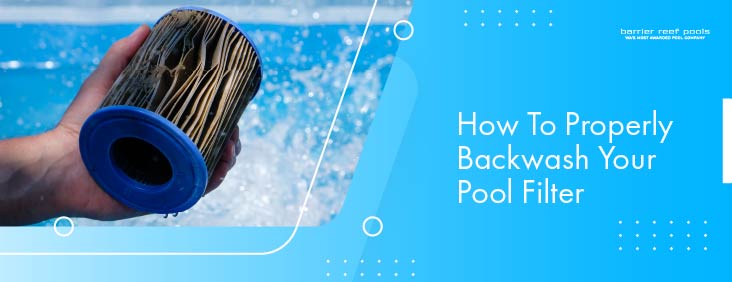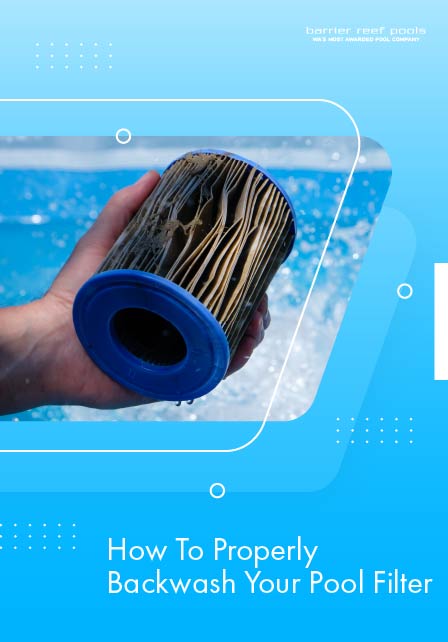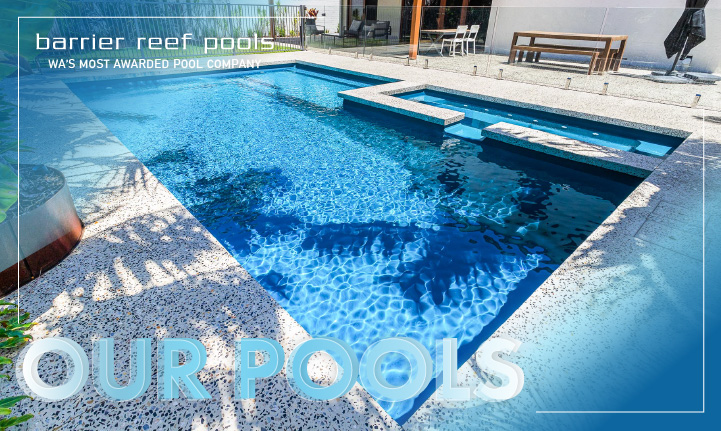Maintaining a sparkling, clean pool is every pool owner's dream, but it requires regular upkeep. One of the most critical aspects of pool maintenance is ensuring that your pool filter is functioning correctly. A well-maintained pool filter is essential for keeping your water clean, healthy, and free from debris. This blog post will delve into the importance of pool filter maintenance, specifically focusing on backwashing, and provide a detailed guide on how to properly backwash different types of pool filters.

What is Backwashing and Why is it Necessary?
Backwashing is a process that involves reversing the flow of water through your pool filter to remove trapped dirt, debris, and contaminants. This process is crucial in maintaining the cleanliness and safety of your pool. Over time, particles such as leaves, insects, and other debris accumulate in the filter media, reducing its efficiency and the overall quality of your pool water. If left unaddressed, these contaminants can lead to murky water, unpleasant odors, and even harmful bacteria growth. Regular backwashing helps maintain optimal filter performance by flushing out these unwanted particles, ensuring that your pool remains clean, safe, and inviting for swimming. Additionally, consistent backwashing extends the lifespan of your pool equipment and reduces the need for more frequent and costly maintenance.
Step-by-Step Guide to Backwashing Different Types of Pool Filters
Sand Filters
Sand filters are among the most common pool filters, and they work by trapping particles in a bed of sand. Here’s how to backwash a sand filter:
- Turn Off the Pump: Ensure the pool pump is off to avoid damage.
Set the Valve to - Backwash: Locate the multiport valve on the filter and turn it to the ‘Backwash’ position.
- Turn On the Pump: Restart the pump and let it run for about 2-3 minutes, or until the water in the sight glass (usually located on the valve) appears clear.
- Rinse the Filter: Turn off the pump again, set the valve to ‘Rinse’, and run the pump for 1-2 minutes. This step helps settle the sand back into place.
- Reset the Valve: Turn off the pump and set the valve back to the ‘Filter’ position.
- Check and Adjust Water Level: Ensure the pool water level is adequate, as backwashing may lower it slightly.
Cartridge Filters
Cartridge filters use a replaceable filter cartridge to trap particles. Here’s how to clean a cartridge filter:
- Turn Off the Pump: Ensure the pool pump is off.
- Release Air: Open the air relief valve to release any built-up pressure.
- Remove the Filter: Open the filter housing and remove the cartridge.
- Clean the Cartridge: Use a hose to rinse off dirt and debris, starting at the top and working your way down. For a deeper clean, soak the cartridge in a filter cleaner solution overnight and rinse thoroughly.
- Reassemble the Filter: Place the cleaned cartridge back into the housing, close it up, and ensure the air relief valve is closed.
- Restart the Pump: Turn on the pump and monitor for any issues.
Diatomaceous Earth (D.E.) Filters
D.E. filters offer superior filtration by using a powder made from fossilised algae. Here’s how to backwash a D.E. filter:
- Turn Off the Pump: Ensure the pool pump is off.
- Set the Valve to Backwash: Turn the multiport valve to the ‘Backwash’ position.
- Turn On the Pump: Restart the pump and let it run for about 2-3 minutes, or until the sight glass water appears clear.
- Turn Off the Pump: Set the valve to the ‘Filter’ position.
- Add New D.E. Powder: Mix the recommended amount of D.E. powder with water to form a slurry and pour it into the skimmer. This step recharges the filter.
- Restart the Pump: Turn on the pump and check for proper operation.

Common Mistakes to Avoid When Backwashing
- Skipping the Rinse Cycle: Failing to rinse the filter after backwashing can result in dirty water returning to the pool.
- Backwashing Too Frequently: Over-backwashing can waste water and reduce filter efficiency. Follow the manufacturer’s recommendations.
- Not Checking the Pressure Gauge: Monitor the pressure gauge regularly and backwash only when the pressure increases by 8-10 psi above the normal level.
- Forgetting to Reset the Valve: Always ensure the valve is set back to ‘Filter’ after completing the backwash process to avoid any system damage.
Tips for Scheduling and Maintaining a Regular Backwashing Routine
- Monitor Filter Pressure: Check the pressure gauge weekly and backwash when necessary.
- Set a Schedule: Depending on pool usage and environmental factors, aim to backwash every 1-2 weeks during peak season.
- Keep Records: Maintain a log of backwashing dates and pressure readings to track the filter’s performance over time.
- Inspect Regularly: Perform routine inspections of the filter system to catch any issues early.

Additional Pool Maintenance Tips
- Skim and Brush: Regularly skim the water surface and brush the pool walls to prevent algae growth.
- Maintain Chemical Balance: Test and adjust the pool’s chemical levels to keep the water safe and clear.
- Clean the Skimmer Basket: Empty the skimmer basket weekly to ensure proper water flow.
- Shock the Pool: Periodically shock the pool to eliminate bacteria and contaminants.
Conclusion
Properly maintaining your pool filter through regular backwashing is essential for clean, healthy pool water. A well-maintained filter efficiently removes debris, contaminants, and impurities, ensuring that your pool remains safe and enjoyable for everyone. By following the steps outlined in this guide, avoiding common mistakes, and adhering to a consistent maintenance schedule, you can ensure your pool filter operates at peak efficiency. This involves checking the pressure gauge, backwashing the filter when needed, and replacing the filter media as recommended by the manufacturer.
Investing time in proper pool filter maintenance not only enhances your swimming experience but also extends the life of your pool equipment, saving you money on repairs and replacements in the long run. A clean filter also reduces the workload on your pool pump, improving overall energy efficiency.
Ready to dive into pristine waters? Follow our comprehensive guide and keep your pool in top condition all year round! From understanding the different types of filters to mastering the backwashing process, we’ve got you covered every step of the way.
Maintaining a sparkling, clean pool is every pool owner's dream, but it requires regular upkeep. One of the most critical aspects of pool maintenance is ensuring that your pool filter is functioning correctly. A well-maintained pool filter is essential for keeping your water clean, healthy, and free from debris. This blog post will delve into the importance of pool filter maintenance, specifically focusing on backwashing, and provide a detailed guide on how to properly backwash different types of pool filters.

What is Backwashing and Why is it Necessary?
Backwashing is a process that involves reversing the flow of water through your pool filter to remove trapped dirt, debris, and contaminants. This process is crucial in maintaining the cleanliness and safety of your pool. Over time, particles such as leaves, insects, and other debris accumulate in the filter media, reducing its efficiency and the overall quality of your pool water. If left unaddressed, these contaminants can lead to murky water, unpleasant odors, and even harmful bacteria growth. Regular backwashing helps maintain optimal filter performance by flushing out these unwanted particles, ensuring that your pool remains clean, safe, and inviting for swimming. Additionally, consistent backwashing extends the lifespan of your pool equipment and reduces the need for more frequent and costly maintenance.
Step-by-Step Guide to Backwashing Different Types of Pool Filters
Sand Filters
Sand filters are among the most common pool filters, and they work by trapping particles in a bed of sand. Here’s how to backwash a sand filter:
- Turn Off the Pump: Ensure the pool pump is off to avoid damage.
Set the Valve to - Backwash: Locate the multiport valve on the filter and turn it to the ‘Backwash’ position.
- Turn On the Pump: Restart the pump and let it run for about 2-3 minutes, or until the water in the sight glass (usually located on the valve) appears clear.
- Rinse the Filter: Turn off the pump again, set the valve to ‘Rinse’, and run the pump for 1-2 minutes. This step helps settle the sand back into place.
- Reset the Valve: Turn off the pump and set the valve back to the ‘Filter’ position.
- Check and Adjust Water Level: Ensure the pool water level is adequate, as backwashing may lower it slightly.
Cartridge Filters
Cartridge filters use a replaceable filter cartridge to trap particles. Here’s how to clean a cartridge filter:
- Turn Off the Pump: Ensure the pool pump is off.
- Release Air: Open the air relief valve to release any built-up pressure.
- Remove the Filter: Open the filter housing and remove the cartridge.
- Clean the Cartridge: Use a hose to rinse off dirt and debris, starting at the top and working your way down. For a deeper clean, soak the cartridge in a filter cleaner solution overnight and rinse thoroughly.
- Reassemble the Filter: Place the cleaned cartridge back into the housing, close it up, and ensure the air relief valve is closed.
- Restart the Pump: Turn on the pump and monitor for any issues.
Diatomaceous Earth (D.E.) Filters
D.E. filters offer superior filtration by using a powder made from fossilised algae. Here’s how to backwash a D.E. filter:
- Turn Off the Pump: Ensure the pool pump is off.
- Set the Valve to Backwash: Turn the multiport valve to the ‘Backwash’ position.
- Turn On the Pump: Restart the pump and let it run for about 2-3 minutes, or until the sight glass water appears clear.
- Turn Off the Pump: Set the valve to the ‘Filter’ position.
- Add New D.E. Powder: Mix the recommended amount of D.E. powder with water to form a slurry and pour it into the skimmer. This step recharges the filter.
- Restart the Pump: Turn on the pump and check for proper operation.

Common Mistakes to Avoid When Backwashing
- Skipping the Rinse Cycle: Failing to rinse the filter after backwashing can result in dirty water returning to the pool.
- Backwashing Too Frequently: Over-backwashing can waste water and reduce filter efficiency. Follow the manufacturer’s recommendations.
- Not Checking the Pressure Gauge: Monitor the pressure gauge regularly and backwash only when the pressure increases by 8-10 psi above the normal level.
- Forgetting to Reset the Valve: Always ensure the valve is set back to ‘Filter’ after completing the backwash process to avoid any system damage.
Tips for Scheduling and Maintaining a Regular Backwashing Routine
- Monitor Filter Pressure: Check the pressure gauge weekly and backwash when necessary.
- Set a Schedule: Depending on pool usage and environmental factors, aim to backwash every 1-2 weeks during peak season.
- Keep Records: Maintain a log of backwashing dates and pressure readings to track the filter’s performance over time.
- Inspect Regularly: Perform routine inspections of the filter system to catch any issues early.

Additional Pool Maintenance Tips
- Skim and Brush: Regularly skim the water surface and brush the pool walls to prevent algae growth.
- Maintain Chemical Balance: Test and adjust the pool’s chemical levels to keep the water safe and clear.
- Clean the Skimmer Basket: Empty the skimmer basket weekly to ensure proper water flow.
- Shock the Pool: Periodically shock the pool to eliminate bacteria and contaminants.
Conclusion
Properly maintaining your pool filter through regular backwashing is essential for clean, healthy pool water. A well-maintained filter efficiently removes debris, contaminants, and impurities, ensuring that your pool remains safe and enjoyable for everyone. By following the steps outlined in this guide, avoiding common mistakes, and adhering to a consistent maintenance schedule, you can ensure your pool filter operates at peak efficiency. This involves checking the pressure gauge, backwashing the filter when needed, and replacing the filter media as recommended by the manufacturer.
Investing time in proper pool filter maintenance not only enhances your swimming experience but also extends the life of your pool equipment, saving you money on repairs and replacements in the long run. A clean filter also reduces the workload on your pool pump, improving overall energy efficiency.
Ready to dive into pristine waters? Follow our comprehensive guide and keep your pool in top condition all year round! From understanding the different types of filters to mastering the backwashing process, we’ve got you covered every step of the way.




